COIT20248 - Systems Analysis & Design: Developing UNICEF Child Care
VerifiedAdded on 2023/06/13
|14
|2673
|320
Report
AI Summary
This report details the systems development process for UNICEF Child Care, focusing on creating a new information system and business portal to address operational issues. The chosen development method is prototyping, with a lifecycle including initiation, prototyping, and production phases. Functional requirements include a business portal for client interaction and automated supply orders, while non-functional requirements cover payment gateway integration and accessibility across devices. The report includes a cost-benefit analysis, project schedule using a Gantt chart and work breakdown structure, and system information requirement investigation techniques such as surveys, interviews, and document analysis. The project aims to improve UNICEF Child Care's business structure and efficiency through the implementation of a well-planned and executed information system.
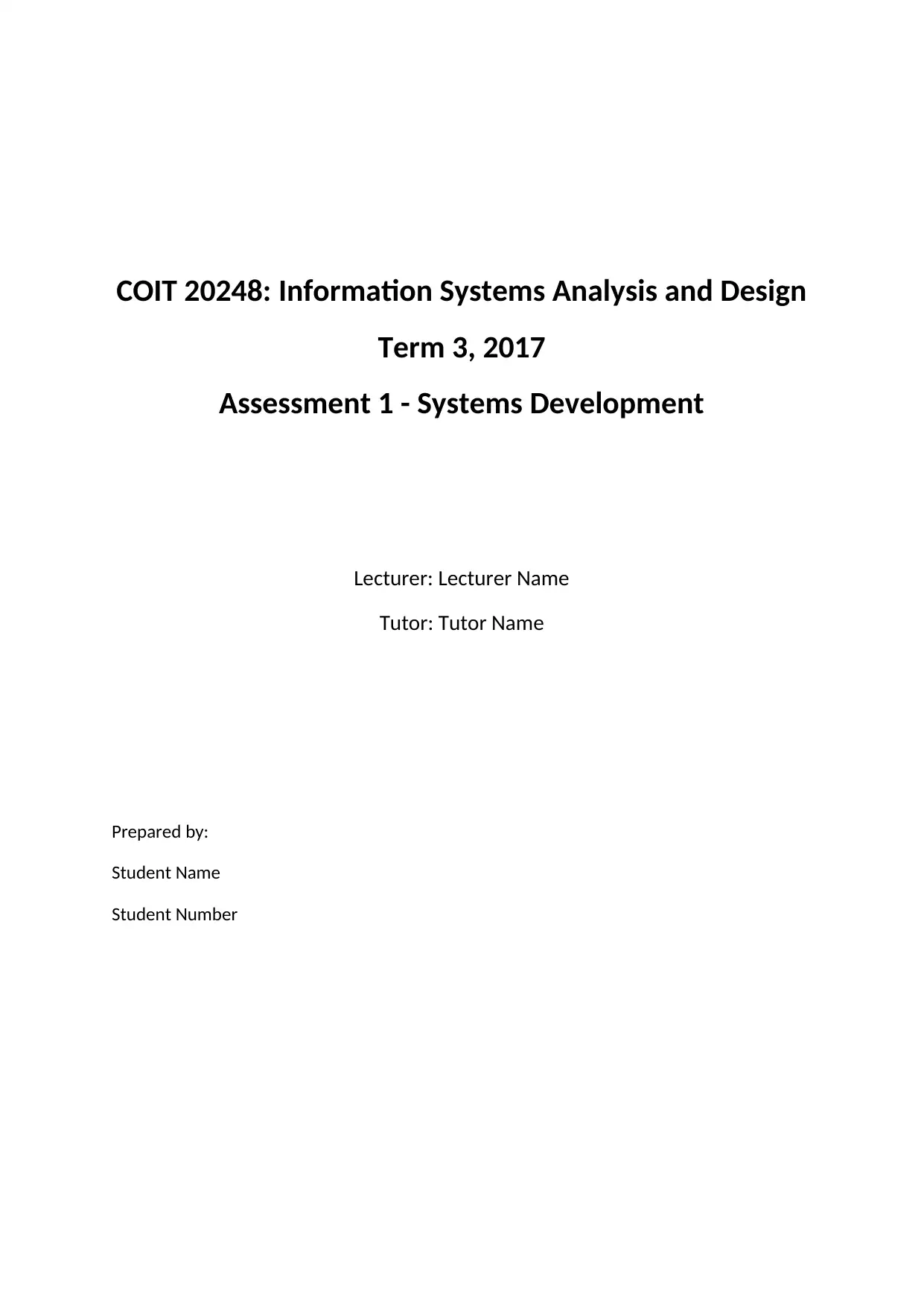
COIT 20248: Information Systems Analysis and Design
Term 3, 2017
Assessment 1 - Systems Development
Lecturer: Lecturer Name
Tutor: Tutor Name
Prepared by:
Student Name
Student Number
Term 3, 2017
Assessment 1 - Systems Development
Lecturer: Lecturer Name
Tutor: Tutor Name
Prepared by:
Student Name
Student Number
Paraphrase This Document
Need a fresh take? Get an instant paraphrase of this document with our AI Paraphraser

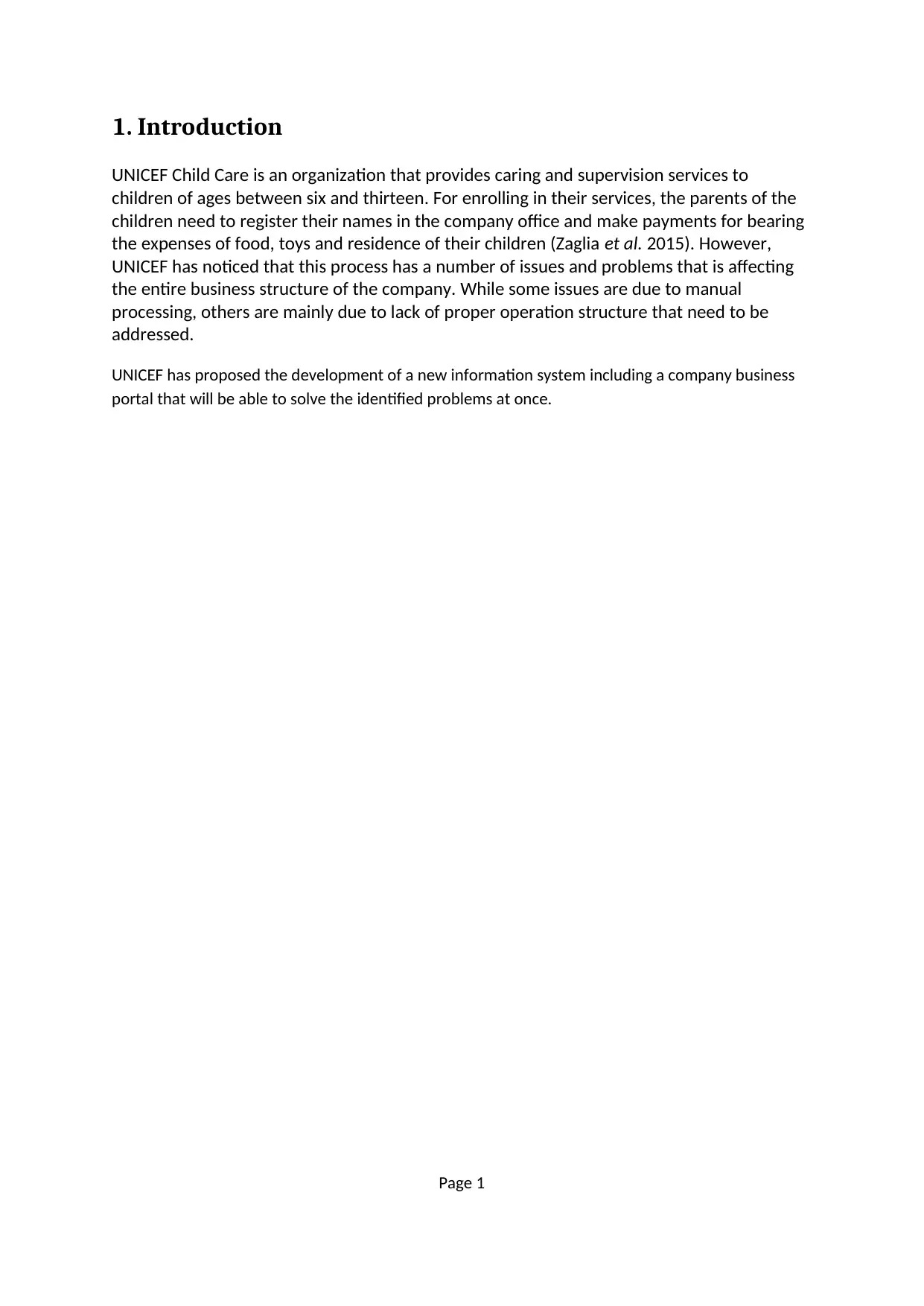
1. Introduction
UNICEF Child Care is an organization that provides caring and supervision services to
children of ages between six and thirteen. For enrolling in their services, the parents of the
children need to register their names in the company office and make payments for bearing
the expenses of food, toys and residence of their children (Zaglia et al. 2015). However,
UNICEF has noticed that this process has a number of issues and problems that is affecting
the entire business structure of the company. While some issues are due to manual
processing, others are mainly due to lack of proper operation structure that need to be
addressed.
UNICEF has proposed the development of a new information system including a company business
portal that will be able to solve the identified problems at once.
Page 1
UNICEF Child Care is an organization that provides caring and supervision services to
children of ages between six and thirteen. For enrolling in their services, the parents of the
children need to register their names in the company office and make payments for bearing
the expenses of food, toys and residence of their children (Zaglia et al. 2015). However,
UNICEF has noticed that this process has a number of issues and problems that is affecting
the entire business structure of the company. While some issues are due to manual
processing, others are mainly due to lack of proper operation structure that need to be
addressed.
UNICEF has proposed the development of a new information system including a company business
portal that will be able to solve the identified problems at once.
Page 1
⊘ This is a preview!⊘
Do you want full access?
Subscribe today to unlock all pages.

Trusted by 1+ million students worldwide
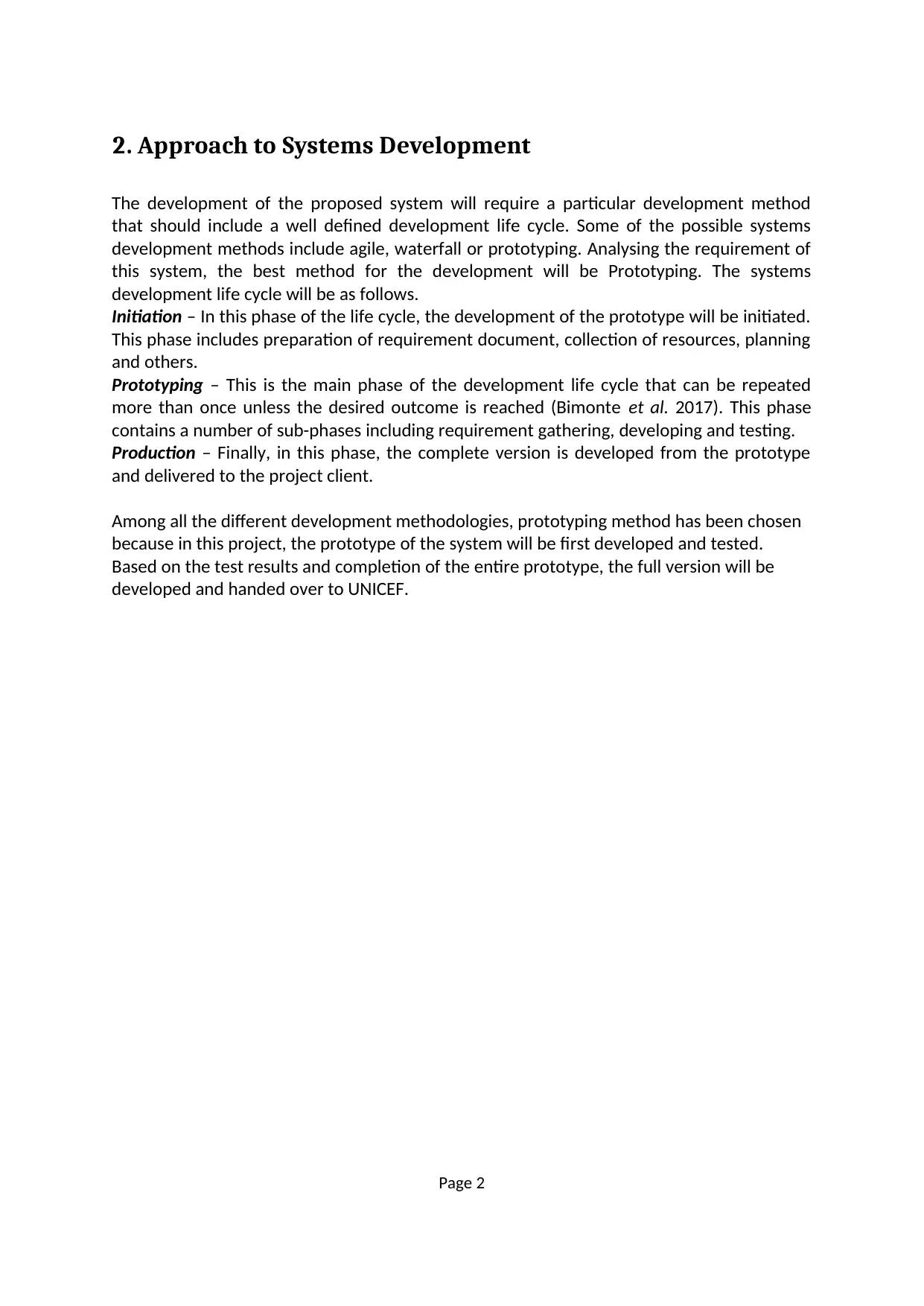
2. Approach to Systems Development
The development of the proposed system will require a particular development method
that should include a well defined development life cycle. Some of the possible systems
development methods include agile, waterfall or prototyping. Analysing the requirement of
this system, the best method for the development will be Prototyping. The systems
development life cycle will be as follows.
Initiation – In this phase of the life cycle, the development of the prototype will be initiated.
This phase includes preparation of requirement document, collection of resources, planning
and others.
Prototyping – This is the main phase of the development life cycle that can be repeated
more than once unless the desired outcome is reached (Bimonte et al. 2017). This phase
contains a number of sub-phases including requirement gathering, developing and testing.
Production – Finally, in this phase, the complete version is developed from the prototype
and delivered to the project client.
Among all the different development methodologies, prototyping method has been chosen
because in this project, the prototype of the system will be first developed and tested.
Based on the test results and completion of the entire prototype, the full version will be
developed and handed over to UNICEF.
Page 2
The development of the proposed system will require a particular development method
that should include a well defined development life cycle. Some of the possible systems
development methods include agile, waterfall or prototyping. Analysing the requirement of
this system, the best method for the development will be Prototyping. The systems
development life cycle will be as follows.
Initiation – In this phase of the life cycle, the development of the prototype will be initiated.
This phase includes preparation of requirement document, collection of resources, planning
and others.
Prototyping – This is the main phase of the development life cycle that can be repeated
more than once unless the desired outcome is reached (Bimonte et al. 2017). This phase
contains a number of sub-phases including requirement gathering, developing and testing.
Production – Finally, in this phase, the complete version is developed from the prototype
and delivered to the project client.
Among all the different development methodologies, prototyping method has been chosen
because in this project, the prototype of the system will be first developed and tested.
Based on the test results and completion of the entire prototype, the full version will be
developed and handed over to UNICEF.
Page 2
Paraphrase This Document
Need a fresh take? Get an instant paraphrase of this document with our AI Paraphraser
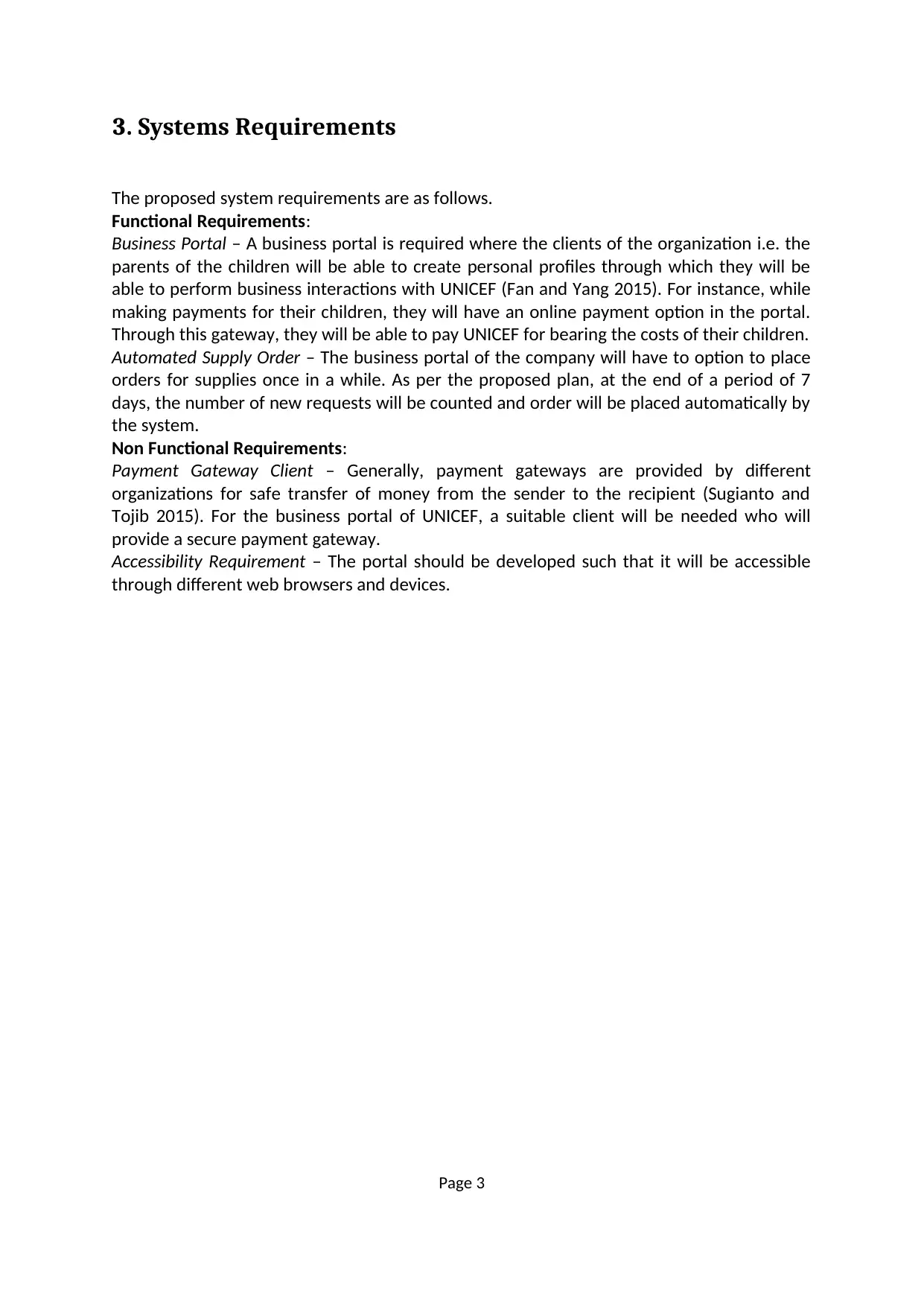
3. Systems Requirements
The proposed system requirements are as follows.
Functional Requirements:
Business Portal – A business portal is required where the clients of the organization i.e. the
parents of the children will be able to create personal profiles through which they will be
able to perform business interactions with UNICEF (Fan and Yang 2015). For instance, while
making payments for their children, they will have an online payment option in the portal.
Through this gateway, they will be able to pay UNICEF for bearing the costs of their children.
Automated Supply Order – The business portal of the company will have to option to place
orders for supplies once in a while. As per the proposed plan, at the end of a period of 7
days, the number of new requests will be counted and order will be placed automatically by
the system.
Non Functional Requirements:
Payment Gateway Client – Generally, payment gateways are provided by different
organizations for safe transfer of money from the sender to the recipient (Sugianto and
Tojib 2015). For the business portal of UNICEF, a suitable client will be needed who will
provide a secure payment gateway.
Accessibility Requirement – The portal should be developed such that it will be accessible
through different web browsers and devices.
Page 3
The proposed system requirements are as follows.
Functional Requirements:
Business Portal – A business portal is required where the clients of the organization i.e. the
parents of the children will be able to create personal profiles through which they will be
able to perform business interactions with UNICEF (Fan and Yang 2015). For instance, while
making payments for their children, they will have an online payment option in the portal.
Through this gateway, they will be able to pay UNICEF for bearing the costs of their children.
Automated Supply Order – The business portal of the company will have to option to place
orders for supplies once in a while. As per the proposed plan, at the end of a period of 7
days, the number of new requests will be counted and order will be placed automatically by
the system.
Non Functional Requirements:
Payment Gateway Client – Generally, payment gateways are provided by different
organizations for safe transfer of money from the sender to the recipient (Sugianto and
Tojib 2015). For the business portal of UNICEF, a suitable client will be needed who will
provide a secure payment gateway.
Accessibility Requirement – The portal should be developed such that it will be accessible
through different web browsers and devices.
Page 3
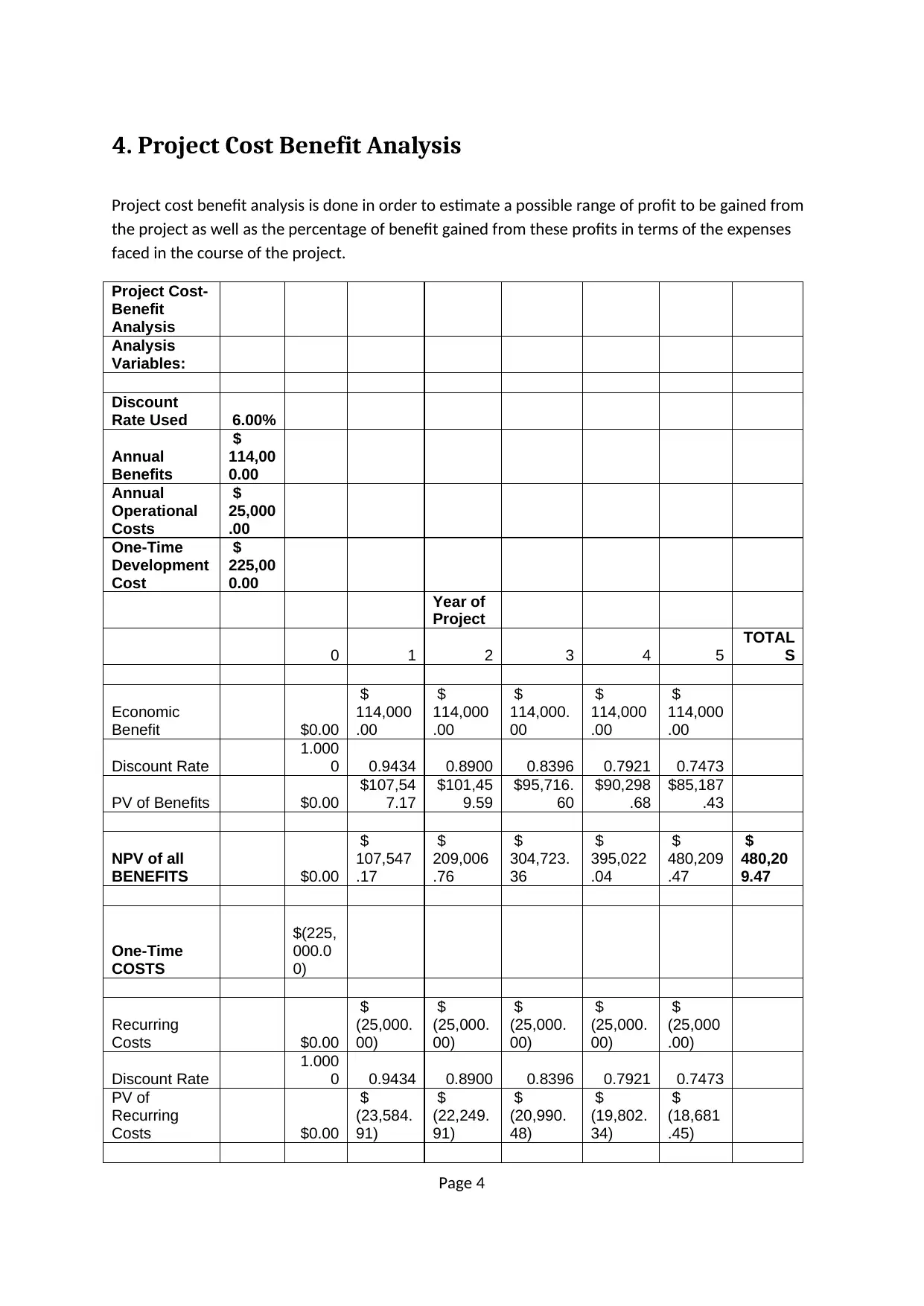
4. Project Cost Benefit Analysis
Project cost benefit analysis is done in order to estimate a possible range of profit to be gained from
the project as well as the percentage of benefit gained from these profits in terms of the expenses
faced in the course of the project.
Project Cost-
Benefit
Analysis
Analysis
Variables:
Discount
Rate Used 6.00%
Annual
Benefits
$
114,00
0.00
Annual
Operational
Costs
$
25,000
.00
One-Time
Development
Cost
$
225,00
0.00
Year of
Project
0 1 2 3 4 5
TOTAL
S
Economic
Benefit $0.00
$
114,000
.00
$
114,000
.00
$
114,000.
00
$
114,000
.00
$
114,000
.00
Discount Rate
1.000
0 0.9434 0.8900 0.8396 0.7921 0.7473
PV of Benefits $0.00
$107,54
7.17
$101,45
9.59
$95,716.
60
$90,298
.68
$85,187
.43
NPV of all
BENEFITS $0.00
$
107,547
.17
$
209,006
.76
$
304,723.
36
$
395,022
.04
$
480,209
.47
$
480,20
9.47
One-Time
COSTS
$(225,
000.0
0)
Recurring
Costs $0.00
$
(25,000.
00)
$
(25,000.
00)
$
(25,000.
00)
$
(25,000.
00)
$
(25,000
.00)
Discount Rate
1.000
0 0.9434 0.8900 0.8396 0.7921 0.7473
PV of
Recurring
Costs $0.00
$
(23,584.
91)
$
(22,249.
91)
$
(20,990.
48)
$
(19,802.
34)
$
(18,681
.45)
Page 4
Project cost benefit analysis is done in order to estimate a possible range of profit to be gained from
the project as well as the percentage of benefit gained from these profits in terms of the expenses
faced in the course of the project.
Project Cost-
Benefit
Analysis
Analysis
Variables:
Discount
Rate Used 6.00%
Annual
Benefits
$
114,00
0.00
Annual
Operational
Costs
$
25,000
.00
One-Time
Development
Cost
$
225,00
0.00
Year of
Project
0 1 2 3 4 5
TOTAL
S
Economic
Benefit $0.00
$
114,000
.00
$
114,000
.00
$
114,000.
00
$
114,000
.00
$
114,000
.00
Discount Rate
1.000
0 0.9434 0.8900 0.8396 0.7921 0.7473
PV of Benefits $0.00
$107,54
7.17
$101,45
9.59
$95,716.
60
$90,298
.68
$85,187
.43
NPV of all
BENEFITS $0.00
$
107,547
.17
$
209,006
.76
$
304,723.
36
$
395,022
.04
$
480,209
.47
$
480,20
9.47
One-Time
COSTS
$(225,
000.0
0)
Recurring
Costs $0.00
$
(25,000.
00)
$
(25,000.
00)
$
(25,000.
00)
$
(25,000.
00)
$
(25,000
.00)
Discount Rate
1.000
0 0.9434 0.8900 0.8396 0.7921 0.7473
PV of
Recurring
Costs $0.00
$
(23,584.
91)
$
(22,249.
91)
$
(20,990.
48)
$
(19,802.
34)
$
(18,681
.45)
Page 4
⊘ This is a preview!⊘
Do you want full access?
Subscribe today to unlock all pages.

Trusted by 1+ million students worldwide

NPV of all
COSTS
$(225,
000.0
0)
$
(248,58
4.91)
$
(270,83
4.82)
$
(291,825
.30)
$
(311,62
7.64)
$
(330,30
9.09)
$
(330,30
9.09)
Overall NPV
$
149,90
0.38
Overall ROI
0.4538
Table 1: Project Cost Benefit Analysis
Page 5
COSTS
$(225,
000.0
0)
$
(248,58
4.91)
$
(270,83
4.82)
$
(291,825
.30)
$
(311,62
7.64)
$
(330,30
9.09)
$
(330,30
9.09)
Overall NPV
$
149,90
0.38
Overall ROI
0.4538
Table 1: Project Cost Benefit Analysis
Page 5
Paraphrase This Document
Need a fresh take? Get an instant paraphrase of this document with our AI Paraphraser
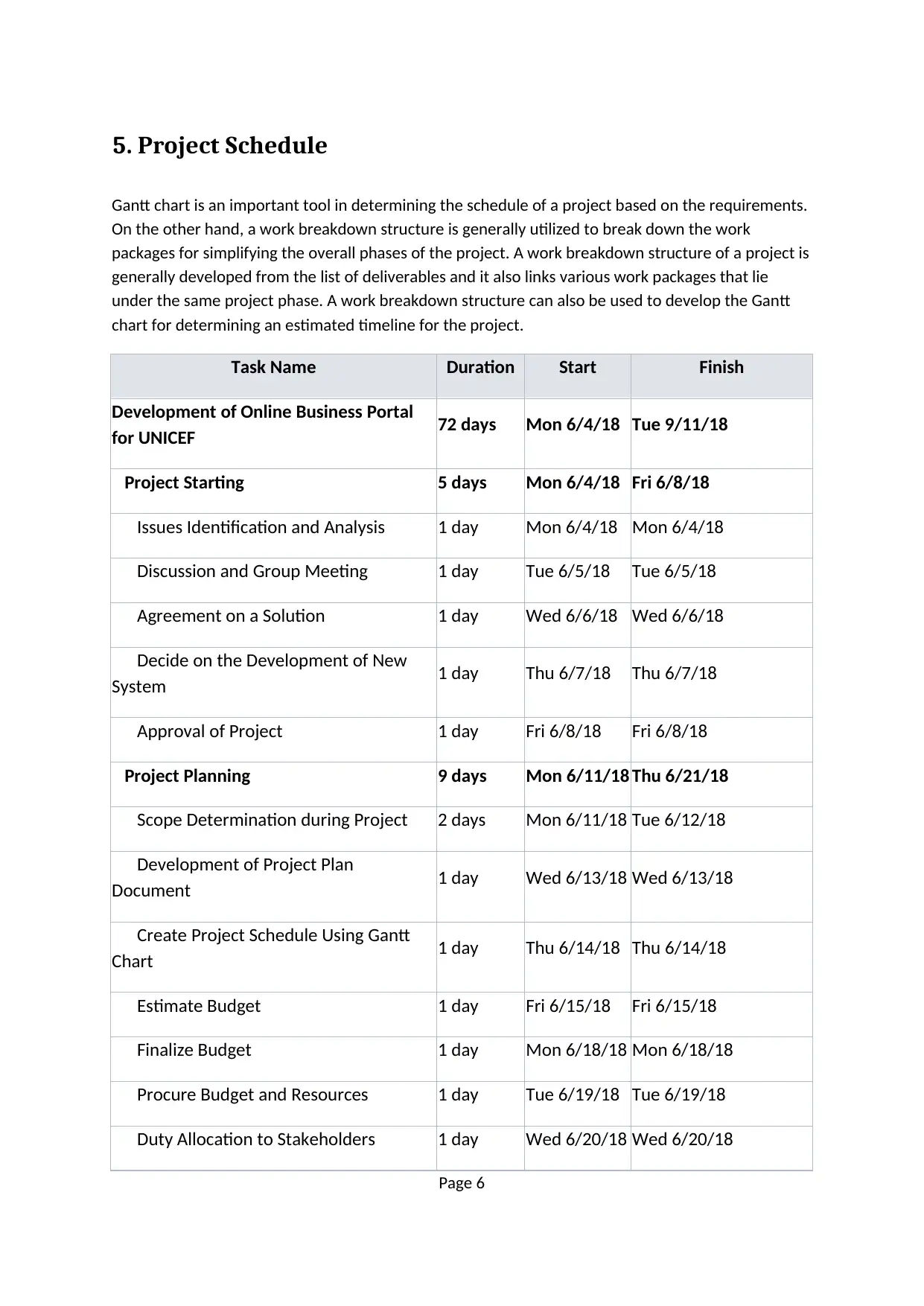
5. Project Schedule
Gantt chart is an important tool in determining the schedule of a project based on the requirements.
On the other hand, a work breakdown structure is generally utilized to break down the work
packages for simplifying the overall phases of the project. A work breakdown structure of a project is
generally developed from the list of deliverables and it also links various work packages that lie
under the same project phase. A work breakdown structure can also be used to develop the Gantt
chart for determining an estimated timeline for the project.
Task Name Duration Start Finish
Development of Online Business Portal
for UNICEF 72 days Mon 6/4/18 Tue 9/11/18
Project Starting 5 days Mon 6/4/18 Fri 6/8/18
Issues Identification and Analysis 1 day Mon 6/4/18 Mon 6/4/18
Discussion and Group Meeting 1 day Tue 6/5/18 Tue 6/5/18
Agreement on a Solution 1 day Wed 6/6/18 Wed 6/6/18
Decide on the Development of New
System 1 day Thu 6/7/18 Thu 6/7/18
Approval of Project 1 day Fri 6/8/18 Fri 6/8/18
Project Planning 9 days Mon 6/11/18 Thu 6/21/18
Scope Determination during Project 2 days Mon 6/11/18 Tue 6/12/18
Development of Project Plan
Document 1 day Wed 6/13/18 Wed 6/13/18
Create Project Schedule Using Gantt
Chart 1 day Thu 6/14/18 Thu 6/14/18
Estimate Budget 1 day Fri 6/15/18 Fri 6/15/18
Finalize Budget 1 day Mon 6/18/18 Mon 6/18/18
Procure Budget and Resources 1 day Tue 6/19/18 Tue 6/19/18
Duty Allocation to Stakeholders 1 day Wed 6/20/18 Wed 6/20/18
Page 6
Gantt chart is an important tool in determining the schedule of a project based on the requirements.
On the other hand, a work breakdown structure is generally utilized to break down the work
packages for simplifying the overall phases of the project. A work breakdown structure of a project is
generally developed from the list of deliverables and it also links various work packages that lie
under the same project phase. A work breakdown structure can also be used to develop the Gantt
chart for determining an estimated timeline for the project.
Task Name Duration Start Finish
Development of Online Business Portal
for UNICEF 72 days Mon 6/4/18 Tue 9/11/18
Project Starting 5 days Mon 6/4/18 Fri 6/8/18
Issues Identification and Analysis 1 day Mon 6/4/18 Mon 6/4/18
Discussion and Group Meeting 1 day Tue 6/5/18 Tue 6/5/18
Agreement on a Solution 1 day Wed 6/6/18 Wed 6/6/18
Decide on the Development of New
System 1 day Thu 6/7/18 Thu 6/7/18
Approval of Project 1 day Fri 6/8/18 Fri 6/8/18
Project Planning 9 days Mon 6/11/18 Thu 6/21/18
Scope Determination during Project 2 days Mon 6/11/18 Tue 6/12/18
Development of Project Plan
Document 1 day Wed 6/13/18 Wed 6/13/18
Create Project Schedule Using Gantt
Chart 1 day Thu 6/14/18 Thu 6/14/18
Estimate Budget 1 day Fri 6/15/18 Fri 6/15/18
Finalize Budget 1 day Mon 6/18/18 Mon 6/18/18
Procure Budget and Resources 1 day Tue 6/19/18 Tue 6/19/18
Duty Allocation to Stakeholders 1 day Wed 6/20/18 Wed 6/20/18
Page 6
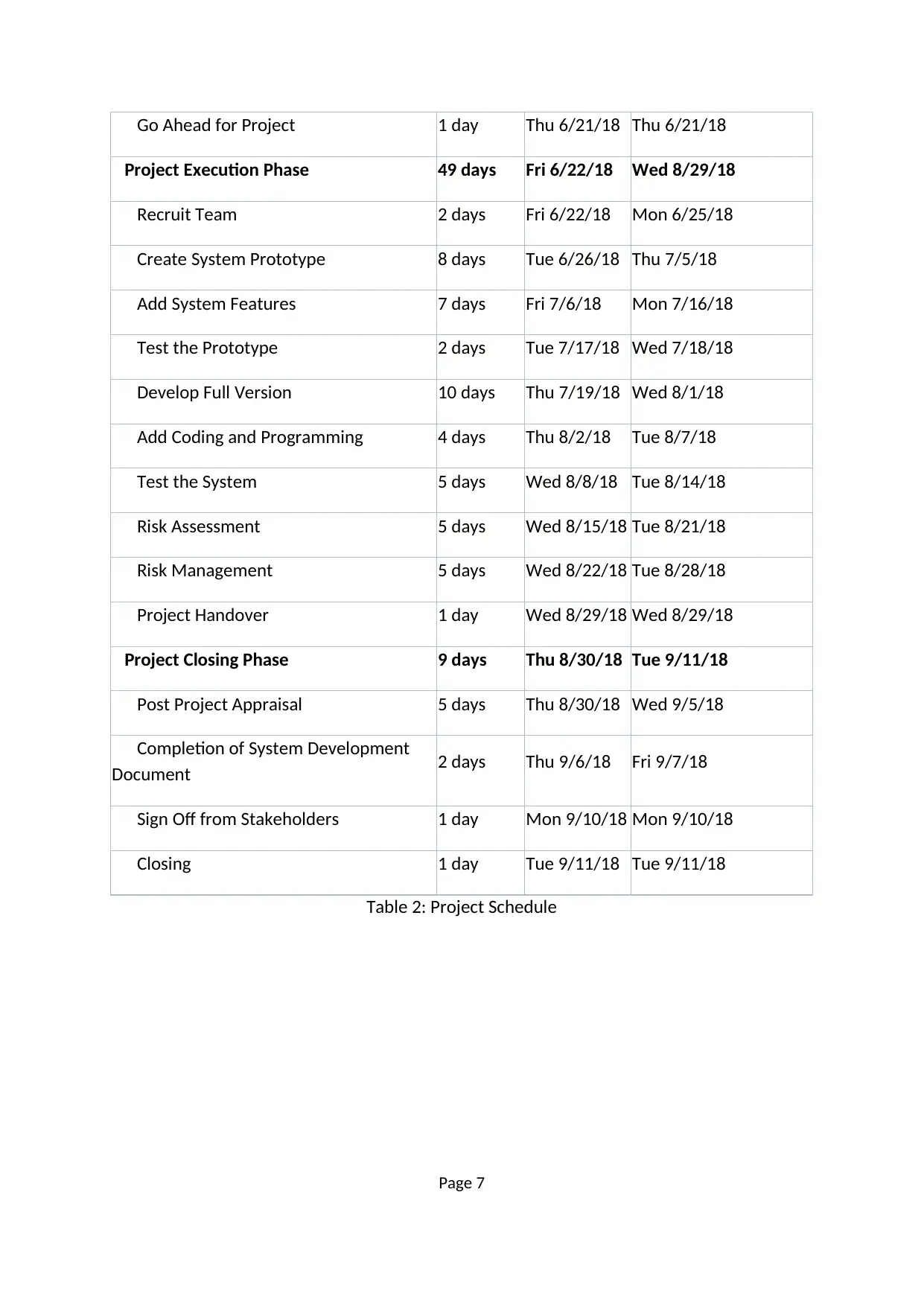
Go Ahead for Project 1 day Thu 6/21/18 Thu 6/21/18
Project Execution Phase 49 days Fri 6/22/18 Wed 8/29/18
Recruit Team 2 days Fri 6/22/18 Mon 6/25/18
Create System Prototype 8 days Tue 6/26/18 Thu 7/5/18
Add System Features 7 days Fri 7/6/18 Mon 7/16/18
Test the Prototype 2 days Tue 7/17/18 Wed 7/18/18
Develop Full Version 10 days Thu 7/19/18 Wed 8/1/18
Add Coding and Programming 4 days Thu 8/2/18 Tue 8/7/18
Test the System 5 days Wed 8/8/18 Tue 8/14/18
Risk Assessment 5 days Wed 8/15/18 Tue 8/21/18
Risk Management 5 days Wed 8/22/18 Tue 8/28/18
Project Handover 1 day Wed 8/29/18 Wed 8/29/18
Project Closing Phase 9 days Thu 8/30/18 Tue 9/11/18
Post Project Appraisal 5 days Thu 8/30/18 Wed 9/5/18
Completion of System Development
Document 2 days Thu 9/6/18 Fri 9/7/18
Sign Off from Stakeholders 1 day Mon 9/10/18 Mon 9/10/18
Closing 1 day Tue 9/11/18 Tue 9/11/18
Table 2: Project Schedule
Page 7
Project Execution Phase 49 days Fri 6/22/18 Wed 8/29/18
Recruit Team 2 days Fri 6/22/18 Mon 6/25/18
Create System Prototype 8 days Tue 6/26/18 Thu 7/5/18
Add System Features 7 days Fri 7/6/18 Mon 7/16/18
Test the Prototype 2 days Tue 7/17/18 Wed 7/18/18
Develop Full Version 10 days Thu 7/19/18 Wed 8/1/18
Add Coding and Programming 4 days Thu 8/2/18 Tue 8/7/18
Test the System 5 days Wed 8/8/18 Tue 8/14/18
Risk Assessment 5 days Wed 8/15/18 Tue 8/21/18
Risk Management 5 days Wed 8/22/18 Tue 8/28/18
Project Handover 1 day Wed 8/29/18 Wed 8/29/18
Project Closing Phase 9 days Thu 8/30/18 Tue 9/11/18
Post Project Appraisal 5 days Thu 8/30/18 Wed 9/5/18
Completion of System Development
Document 2 days Thu 9/6/18 Fri 9/7/18
Sign Off from Stakeholders 1 day Mon 9/10/18 Mon 9/10/18
Closing 1 day Tue 9/11/18 Tue 9/11/18
Table 2: Project Schedule
Page 7
⊘ This is a preview!⊘
Do you want full access?
Subscribe today to unlock all pages.

Trusted by 1+ million students worldwide
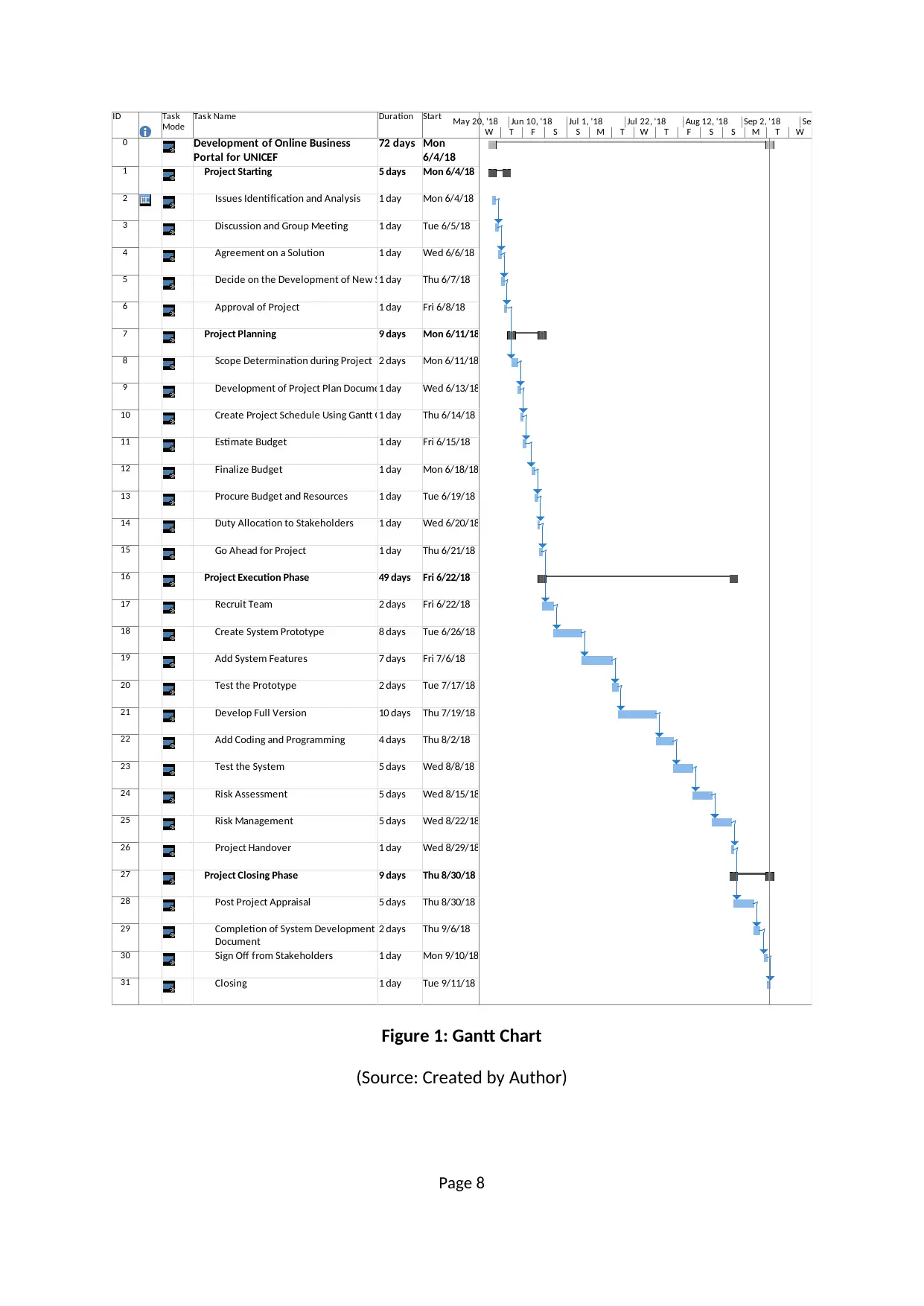
ID Task
Mode
Task Name Duration Start
0 Development of Online Business
Portal for UNICEF
72 days Mon
6/4/18
1 Project Starting 5 days Mon 6/4/18
2 Issues Identification and Analysis 1 day Mon 6/4/18
3 Discussion and Group Meeting 1 day Tue 6/5/18
4 Agreement on a Solution 1 day Wed 6/6/18
5 Decide on the Development of New System1 day Thu 6/7/18
6 Approval of Project 1 day Fri 6/8/18
7 Project Planning 9 days Mon 6/11/18
8 Scope Determination during Project 2 days Mon 6/11/18
9 Development of Project Plan Document1 day Wed 6/13/18
10 Create Project Schedule Using Gantt Chart1 day Thu 6/14/18
11 Estimate Budget 1 day Fri 6/15/18
12 Finalize Budget 1 day Mon 6/18/18
13 Procure Budget and Resources 1 day Tue 6/19/18
14 Duty Allocation to Stakeholders 1 day Wed 6/20/18
15 Go Ahead for Project 1 day Thu 6/21/18
16 Project Execution Phase 49 days Fri 6/22/18
17 Recruit Team 2 days Fri 6/22/18
18 Create System Prototype 8 days Tue 6/26/18
19 Add System Features 7 days Fri 7/6/18
20 Test the Prototype 2 days Tue 7/17/18
21 Develop Full Version 10 days Thu 7/19/18
22 Add Coding and Programming 4 days Thu 8/2/18
23 Test the System 5 days Wed 8/8/18
24 Risk Assessment 5 days Wed 8/15/18
25 Risk Management 5 days Wed 8/22/18
26 Project Handover 1 day Wed 8/29/18
27 Project Closing Phase 9 days Thu 8/30/18
28 Post Project Appraisal 5 days Thu 8/30/18
29 Completion of System Development
Document
2 days Thu 9/6/18
30 Sign Off from Stakeholders 1 day Mon 9/10/18
31 Closing 1 day Tue 9/11/18
W T F S S M T W T F S S M T W T
May 20, '18 Jun 10, '18 Jul 1, '18 Jul 22, '18 Aug 12, '18 Sep 2, '18 Sep 23, '18
Figure 1: Gantt Chart
(Source: Created by Author)
Page 8
Mode
Task Name Duration Start
0 Development of Online Business
Portal for UNICEF
72 days Mon
6/4/18
1 Project Starting 5 days Mon 6/4/18
2 Issues Identification and Analysis 1 day Mon 6/4/18
3 Discussion and Group Meeting 1 day Tue 6/5/18
4 Agreement on a Solution 1 day Wed 6/6/18
5 Decide on the Development of New System1 day Thu 6/7/18
6 Approval of Project 1 day Fri 6/8/18
7 Project Planning 9 days Mon 6/11/18
8 Scope Determination during Project 2 days Mon 6/11/18
9 Development of Project Plan Document1 day Wed 6/13/18
10 Create Project Schedule Using Gantt Chart1 day Thu 6/14/18
11 Estimate Budget 1 day Fri 6/15/18
12 Finalize Budget 1 day Mon 6/18/18
13 Procure Budget and Resources 1 day Tue 6/19/18
14 Duty Allocation to Stakeholders 1 day Wed 6/20/18
15 Go Ahead for Project 1 day Thu 6/21/18
16 Project Execution Phase 49 days Fri 6/22/18
17 Recruit Team 2 days Fri 6/22/18
18 Create System Prototype 8 days Tue 6/26/18
19 Add System Features 7 days Fri 7/6/18
20 Test the Prototype 2 days Tue 7/17/18
21 Develop Full Version 10 days Thu 7/19/18
22 Add Coding and Programming 4 days Thu 8/2/18
23 Test the System 5 days Wed 8/8/18
24 Risk Assessment 5 days Wed 8/15/18
25 Risk Management 5 days Wed 8/22/18
26 Project Handover 1 day Wed 8/29/18
27 Project Closing Phase 9 days Thu 8/30/18
28 Post Project Appraisal 5 days Thu 8/30/18
29 Completion of System Development
Document
2 days Thu 9/6/18
30 Sign Off from Stakeholders 1 day Mon 9/10/18
31 Closing 1 day Tue 9/11/18
W T F S S M T W T F S S M T W T
May 20, '18 Jun 10, '18 Jul 1, '18 Jul 22, '18 Aug 12, '18 Sep 2, '18 Sep 23, '18
Figure 1: Gantt Chart
(Source: Created by Author)
Page 8
Paraphrase This Document
Need a fresh take? Get an instant paraphrase of this document with our AI Paraphraser
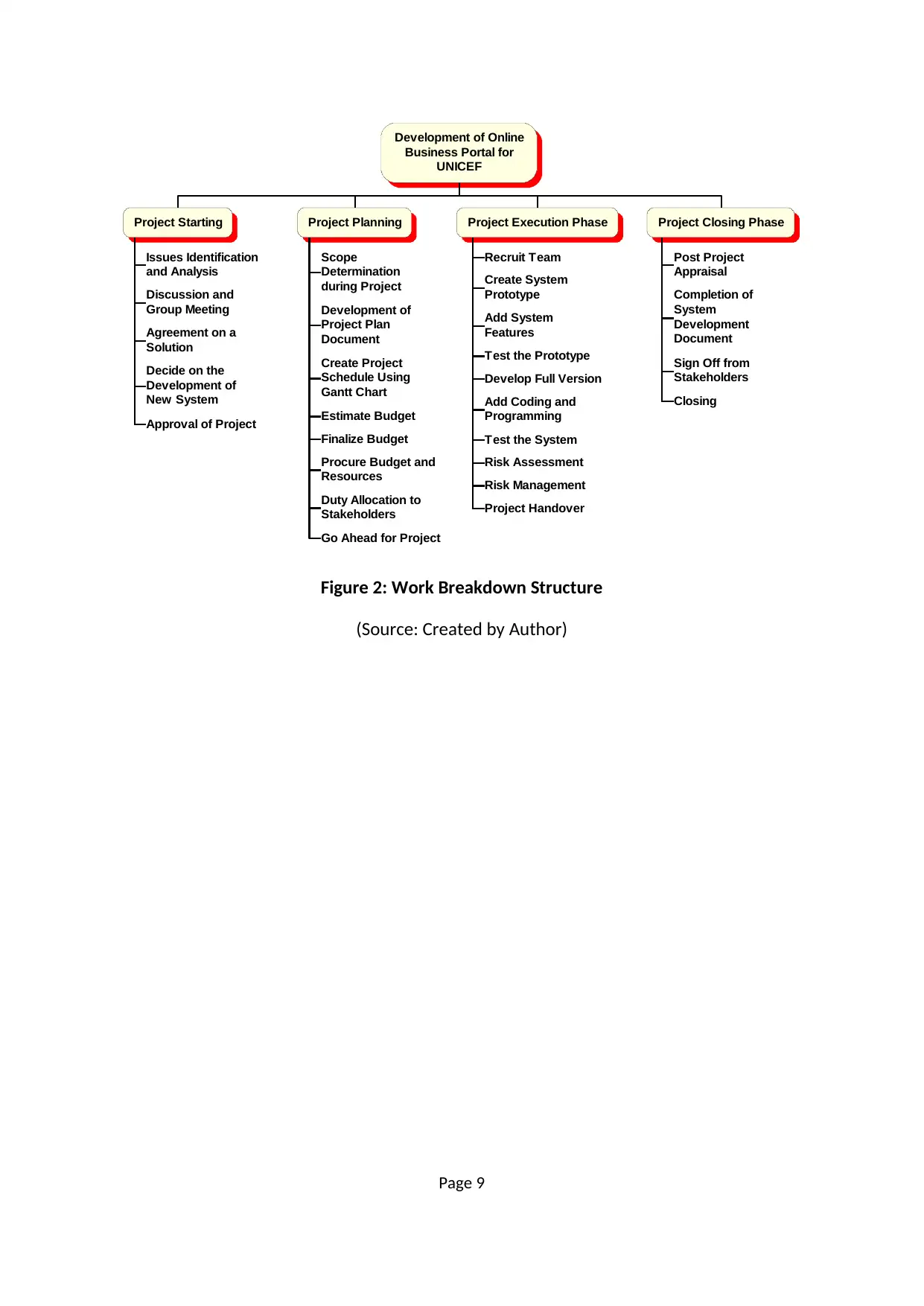
Development of Online
Business Portal for
UNICEF
Project Starting
Issues Identification
and Analysis
Discussion and
Group Meeting
Agreement on a
Solution
Decide on the
Development of
New System
Approval of Project
Project Planning
Scope
Determination
during Project
Development of
Project Plan
Document
Create Project
Schedule Using
Gantt Chart
Estimate Budget
Finalize Budget
Procure Budget and
Resources
Duty Allocation to
Stakeholders
Go Ahead for Project
Project Execution Phase
Recruit Team
Create System
Prototype
Add System
Features
Test the Prototype
Develop Full Version
Add Coding and
Programming
Test the System
Risk Assessment
Risk Management
Project Handover
Project Closing Phase
Post Project
Appraisal
Completion of
System
Development
Document
Sign Off from
Stakeholders
Closing
Figure 2: Work Breakdown Structure
(Source: Created by Author)
Page 9
Business Portal for
UNICEF
Project Starting
Issues Identification
and Analysis
Discussion and
Group Meeting
Agreement on a
Solution
Decide on the
Development of
New System
Approval of Project
Project Planning
Scope
Determination
during Project
Development of
Project Plan
Document
Create Project
Schedule Using
Gantt Chart
Estimate Budget
Finalize Budget
Procure Budget and
Resources
Duty Allocation to
Stakeholders
Go Ahead for Project
Project Execution Phase
Recruit Team
Create System
Prototype
Add System
Features
Test the Prototype
Develop Full Version
Add Coding and
Programming
Test the System
Risk Assessment
Risk Management
Project Handover
Project Closing Phase
Post Project
Appraisal
Completion of
System
Development
Document
Sign Off from
Stakeholders
Closing
Figure 2: Work Breakdown Structure
(Source: Created by Author)
Page 9
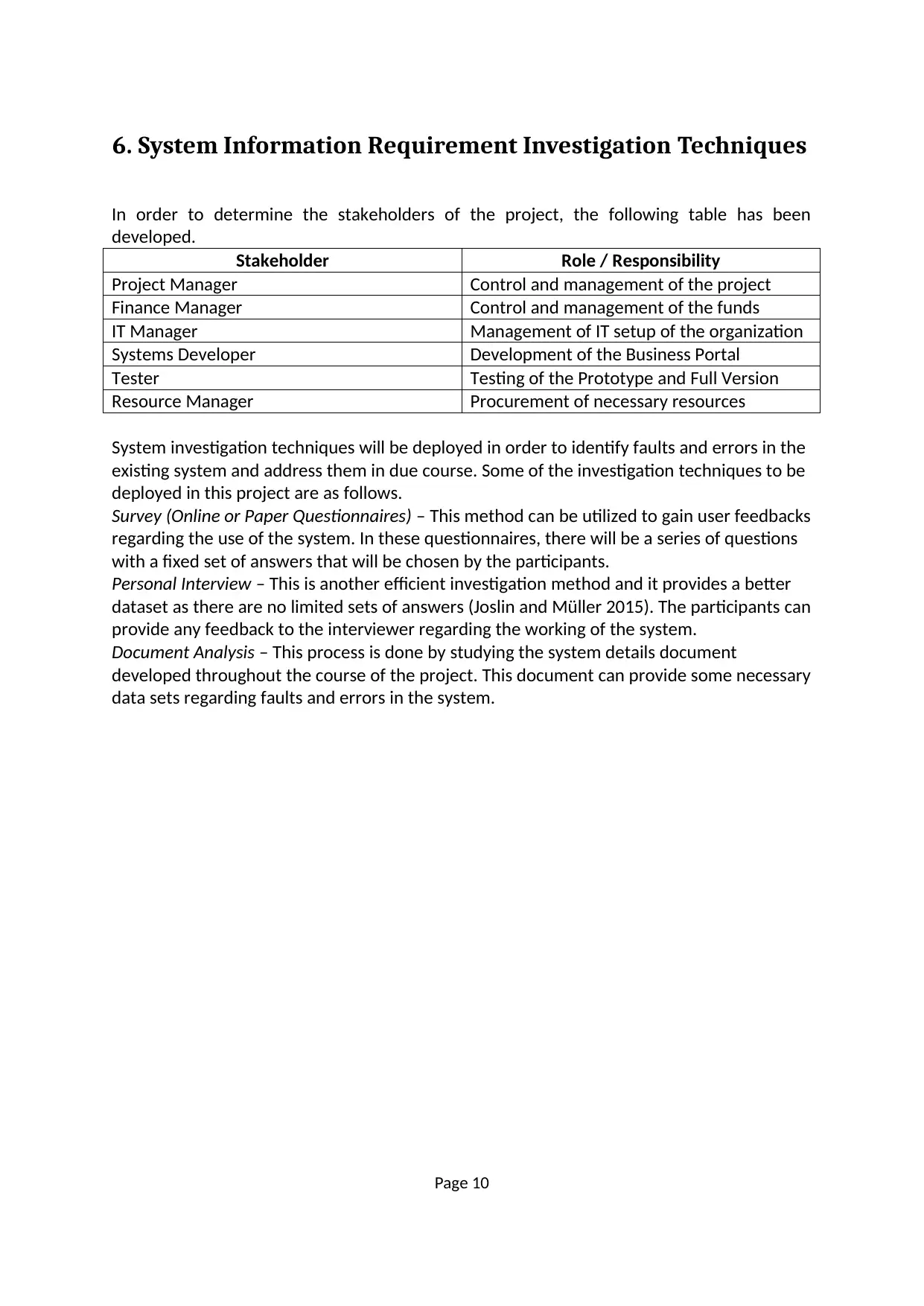
6. System Information Requirement Investigation Techniques
In order to determine the stakeholders of the project, the following table has been
developed.
Stakeholder Role / Responsibility
Project Manager Control and management of the project
Finance Manager Control and management of the funds
IT Manager Management of IT setup of the organization
Systems Developer Development of the Business Portal
Tester Testing of the Prototype and Full Version
Resource Manager Procurement of necessary resources
System investigation techniques will be deployed in order to identify faults and errors in the
existing system and address them in due course. Some of the investigation techniques to be
deployed in this project are as follows.
Survey (Online or Paper Questionnaires) – This method can be utilized to gain user feedbacks
regarding the use of the system. In these questionnaires, there will be a series of questions
with a fixed set of answers that will be chosen by the participants.
Personal Interview – This is another efficient investigation method and it provides a better
dataset as there are no limited sets of answers (Joslin and Müller 2015). The participants can
provide any feedback to the interviewer regarding the working of the system.
Document Analysis – This process is done by studying the system details document
developed throughout the course of the project. This document can provide some necessary
data sets regarding faults and errors in the system.
Page 10
In order to determine the stakeholders of the project, the following table has been
developed.
Stakeholder Role / Responsibility
Project Manager Control and management of the project
Finance Manager Control and management of the funds
IT Manager Management of IT setup of the organization
Systems Developer Development of the Business Portal
Tester Testing of the Prototype and Full Version
Resource Manager Procurement of necessary resources
System investigation techniques will be deployed in order to identify faults and errors in the
existing system and address them in due course. Some of the investigation techniques to be
deployed in this project are as follows.
Survey (Online or Paper Questionnaires) – This method can be utilized to gain user feedbacks
regarding the use of the system. In these questionnaires, there will be a series of questions
with a fixed set of answers that will be chosen by the participants.
Personal Interview – This is another efficient investigation method and it provides a better
dataset as there are no limited sets of answers (Joslin and Müller 2015). The participants can
provide any feedback to the interviewer regarding the working of the system.
Document Analysis – This process is done by studying the system details document
developed throughout the course of the project. This document can provide some necessary
data sets regarding faults and errors in the system.
Page 10
⊘ This is a preview!⊘
Do you want full access?
Subscribe today to unlock all pages.

Trusted by 1+ million students worldwide
1 out of 14
Related Documents
Your All-in-One AI-Powered Toolkit for Academic Success.
+13062052269
info@desklib.com
Available 24*7 on WhatsApp / Email
![[object Object]](/_next/static/media/star-bottom.7253800d.svg)
Unlock your academic potential
Copyright © 2020–2025 A2Z Services. All Rights Reserved. Developed and managed by ZUCOL.




